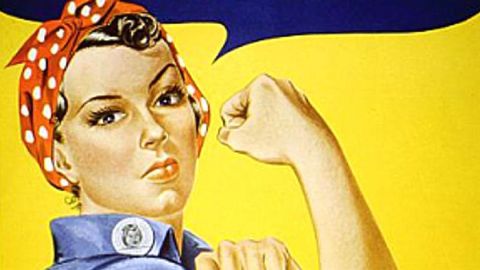We’ve Come a Long Way, Maybe

There were two really important elements that I discovered when I was looking at women’s history and the history of the women’s movement in the US. The first thing that I realized was that we don’t learn about women in history. Now there are some famous women historians now, but even they pretty much operate under the male model, that history has been pretty much been written by men who put themselves as the protagonists, the actors, and women were the supporting cast.
Through much of history we didn’t live that long and it was mostly adolescent boys who were starting wars, and so wars became the defining narrative of history. I’ve often wondered whether if women had been writing the history for all these years, instead of war as the defining narrative, perhaps keeping peace might have been it because it was in women’s best interest to keep the peace to be able to nurture their children and keep their households going and it’s just kind of an interesting thing to contemplate if you turn the world upside down—and how it will help you think differently about what might have happened.
The consequence of this is that girls grew up not knowing much about women as role models in history and if you can’t see it you can’t be it, as they say. I teach a college class called “Women, Power and Leadership,” and I always do a photo slideshow of famous women in history and I find that the class almost never knows anybody. They almost can’t recognize anybody. They might recognize Gloria Steinem if I use the old picture of her in her aviator glasses, but they won’t recognize anybody until I get to Danica Patrick and then they’ll know her. They’ll know some pop culture women, but they really won’t know women in history who have done amazing things, invented things, created things, started movements, started social movements and so forth.
So that’s one thing. We just don’t see women in these powerful roles. We don’t realize that we wouldn’t have our computers today if it hadn’t been, for example, Ada Lovelace who actually designed the first algorithms that enabled computer programming to begin. We don’t know stuff like that.
So then I realized that there has been a pattern and this has to do with our ambivalent relationship with power — that women will start to move into power and then we will step back on our own volition, or so it appears. Ever since Abigail Adams told John to remember the ladies when writing the Constitution — and they didn’t remember the ladies — he made fun of her. He said the men would not put up with this ‘tyranny of the petticoat.’ But the problem is that the other thing Abigail said was, “Or we will foment a revolution.” But the women didn’t foment a revolution and they should have fomented a revolution at that time. If they had, think about what a difference it might have made. It might not have taken us until 1920 to get the right to vote because women weren’t even assumed to be people in the Constitution of the United States.
So there we started, and then that pattern continued. The first Women’s Rights Convention in the US was at Seneca Falls in 1848 and there were great declarations of the importance of women’s rights but they were still afraid to even talk about women’s suffrage. They thought that was too radical and they finally got there and they started talking about it and then they joined with abolitionists, which was a very, very smart thing to do as both groups —African-Americans and women—were trying to basically become citizens under the Constitution. What happened then was that they began to break apart and the women agreed to step back and say that abolition was more important than the women’s movement. And so that kind of thing is like taking the boney parts of the chicken for yourself in the family meal. It’s that kind of thing that has happened over and over and over again.
When women finally got the right to vote in 1920, by that time they had narrowed their argument for why women should be able to vote to “Well, it won’t matter because they’ll just vote like their husbands anyway,” and they completely left behind the broader progressive agenda that the women’s movement had traditionally been. They were talking about universal healthcare and childcare and worker’s rights and all of those things at the later part of the 19th century and the early part of the 20th century. They were talking about all that then, but they had given it up by the time they got the right to vote in 1920 and the women’s movement dissipated.
So then we can go to Rosie the Riveter. The women went to work during World War II. Then they went back home voluntarily when Johnny came marching home, and they didn’t, you know. They just said “Well that’s okay,” and today we see many young women who have been well educated and who really can have a fabulous profession opting to stay home, opting out, opting out in a way where they really can’t go back.
Now there are ways you can opt out for awhile and then go back into your profession, but instead of doing that they just decide “Forget it, I’m going to opt out completely,” and all of these things set other women back because the next woman who applies for that job they’re going to be greeted with a “Yeah, but you’ll just get pregnant and leave,” so it really truncates careers for all women when womenn who are capable, the high performing women, decide to opt out of the workplace. That’s our problem today.
So that’s why I say we’ve come a long way, maybe, and we still have a long way to go.





